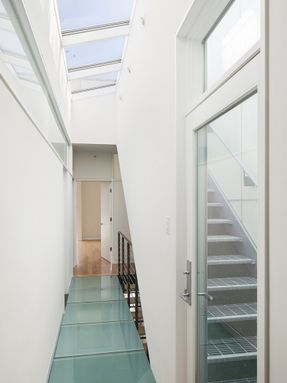ARCHITECTS
Onion Flats
YEAR
2009
LOCATION
PHILADELPHIA, UNITED STATES
MANUFACTURERS
Trespa, Grohe, Caroma, En-Motion Design, Fagor, G.R.A.S.S., Jeld-Wen, Liz Kinder Ceramics, Modulnova
STRUCTURAL ENGINEER
Associated Engineering Consultants Inc.
GENERAL CONTRACTOR
JIG Inc, Kurt Schlenbaker
GREEN ROOF & RAINWATER HARVESTING
G.R.A.S.S. (Green Roots And Solar Systems)
LEED RATER
Magrann Associates (Sam Klein)
OWNER / DEVELOPER
Onion Flats
PROJECT TEAM
Tim McDonald, Howard Steinberg, Jim Sanderson
CATEGORY
PHOTOGRAPHS
Mariko Reed, Sam Oberter, Tim McDonald
Text description provided by architect.
This eight unit residential project explores the highly efficient and architecturally latent potentials hidden within the traditional form of the Philadelphia“Row” home.
The vertical rhythm, regularity yet diversity of this most prevalent residential urban typology was the primary source of inspiration for this experiment.
Thin faces fronting both Laurel and Pollard Streets mask and blur conventional lines of demarcation between all eight duplex dwellings both vertically and horizontally. In the process, a degree of density yet expansiveness uncommon to the thin space of the urban duplex emerges.
The Philadelphia “Row” is by nature a long, thin slice of dense, sustainable, urban space, typically ‘light-deficient’ and insular at its core.
Thin Flats questions this traditional ‘deficiency’ by spatially reconfiguring the relationship between the interior and it’s skin such that its ‘core’ is flooded with light and air.This skin also affords each room on the ‘periphery’ of the dwelling the ability to step outside, and yet remain within the skin.
VOID
Surface: Veil The façade of Thin Flats is at once a surface and a void, blurring the limits of the units within.
The façade of the lower units is pushed back from the sidewalk to accommodate circulation, flood a ‘basement’ space with light, aid in solar shading and create a veil from public view.Balconies on upper floors recess from behind the surface of the veil to create opportunities for civic engagement within the thin space of the façade.
SUSTAINABLE ELEMENTS
- Third Party verification that each unit is a minimum 50% more energy efficient in cooling, and domestic hot water energy usage than required by code
- Solar Thermal panels to provide domestic hot water needs.
- Planted ‘green’ roofs to decrease thermal heat gain, prolong roof life, assist in storm water management, and provide planted and habitable rooftop gardens with views of center city.
- Rainwater harvesting cisterns beneath parking area for irrigation of yards / gardens.
- Each unit includes a detailed Home Owner’s Manual outlining the specific features and systems that are offered in the home that make it a LEED Platinum project,.
- Low flow faucets and fixtures reduce water consumption by 50%.
- Concrete containing a minimum of 25% recycled fl y ash content
- Double pane, low E, argon filled, thermally broken, aluminum clad wood windows and doors
- Home automation technology by Colorado vNet
– Centralized and programmable lighting, heating, cooling, security, and audio/video entertainment system to maximize convenience and minimize energy use.
- Grade 1 insulation package including foam sealing of all joints to minimize air infiltration and closed cell spray-in foam insulation in exterior walls.
- Maximum use of sustainable framing materials.
- Maximum use of locally sourced / manufactured materials
- Hydronic radiant in-floor heating system.
- HVAC system designed to ACCA Manual recommendations.
- HRV(Heat Recovery Ventilation) system.
- Insulated hot water supply pipes - Located within one block of public transportation
- Low or no VOC (volatile organic compounds) emitting paints, adhesives, and sealants.
- Located within one block of public transportation
- Electric car charging port with fully electric car optional




























